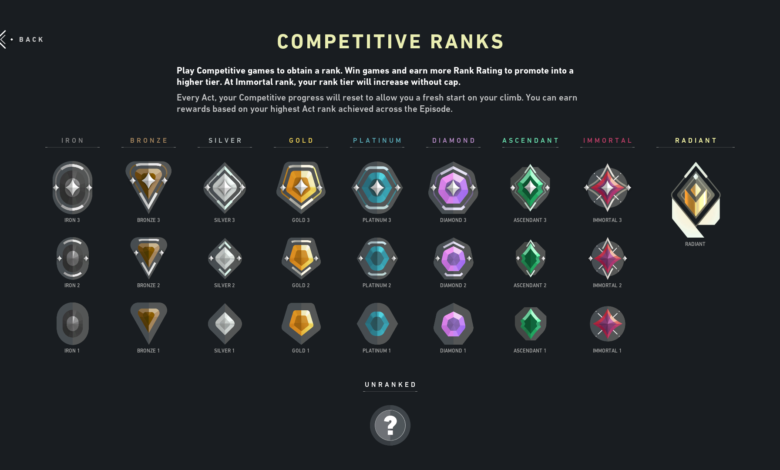Understanding Valorant Rank: A Comprehensive Guide to Climbing the Ranks

Introduction to Valorant Ranks
In the competitive landscape of Valorant, ranks serve as a crucial measurement of a player’s skill level and capability in gameplay. The Valorant rank system is meticulously designed to provide players with an accurate representation of their proficiency and ability to compete against others. Each rank, ranging from Iron to Radiant, signifies a different tier of skill and expertise, categorizing players based on their performance in matches.
Understanding the purpose of these ranks is essential not only for new players but also for veterans who seek to enhance their gameplay. The ranks offer a structured pathway that encourages players to improve their skills, develop strategies, and engage in cooperative play with teammates. As players aim to advance through the ranks, they often experience increased challenges that contribute to their growth in the game.
The overall significance of ranks extends beyond just competition; it fosters a sense of achievement and progression that drives players to continuously strive for improvement. Each advancement in rank reflects dedication, effort, and a comprehensive understanding of gameplay mechanics. Consequently, players often set personal goals aligned with their desired Valorant rank, motivating them to practice diligently and refine their skills.
Furthermore, the ranking system plays a pivotal role in matchmaking. It ensures that players are paired with opponents of comparable skill levels, enhancing the gaming experience and promoting fair competition. This matchmaking system not only maintains engagement but also ensures that players remain committed to climbing the ranks, as the thrill of competing against others of similar abilities is intrinsically rewarding.
The Ranking System Explained
The Valorant ranking system consists of several tiers and divisions that categorize players’ skill levels. These tiers are crucial for providing a structured competitive experience, as they allow for balanced matchmaking and ensure that players face opponents with similar abilities. The ranks are segmented into Iron, Bronze, Silver, Gold, Platinum, Diamond, Immortal, and Radiant, each representing a progressively higher skill level.
At the base level, players begin in Iron, which is divided into Iron 1, Iron 2, and Iron 3. This tier serves as the entry point for new players who are learning the game mechanics and strategic elements. As players improve, they progress through Bronze and Silver, where they further refine their skills and gain a better understanding of teamwork and game strategies. Each rank tier is subdivided into three divisions to provide a more nuanced understanding of varying skill levels.
Upon reaching Gold and Platinum, players are expected to demonstrate more advanced gameplay techniques, including map knowledge, shooting accuracy, and game sense. At the Diamond rank and beyond, players compete at a notably higher skill level, with Immortal being the threshold before entering the top tier of Radiant. Radiant, the highest rank, is comprised of only a select few, showcasing the pinnacle of individual skill and teamwork. Climbing the ranks is influenced not only by personal performance but also by match results, where players must consistently win to ascend through the Valorant rank hierarchy.
Matchmaking conditions further play a role in determining a player’s placement in the ranked system. Factors such as individual performance metrics, match outcomes, and the ranks of opponents contribute to this dynamic system. Overall, understanding the Valorant rank system is essential for any player seeking to improve and compete effectively in this tactical shooter.
How Placement Matches Work
Placement matches are a crucial component of the competitive experience in Valorant, serving as the foundation for establishing a player’s initial rank. When a player first enters Competitive mode, they are required to complete a series of placement matches, typically five in number. These matches are instrumental in assessing a player’s skill level and subsequently determining their starting rank within the Valorant ranking system.
The outcome of these placement matches is influenced by several factors, including individual performance metrics such as kills, deaths, assists, and overall game impact. Additionally, the results of these matches—whether the player wins or loses—play a significant role in rank placement. It’s essential to recognize that simply winning or losing is not the sole determinant; rather, the consistency and quality of performance are equally critical. For instance, a player might secure a higher starting rank by excelling in their gameplay, even if they do not win every match.
Moreover, the ranks of teammates and opponents encountered during these placement matches can also affect the assessment process. If a player competes against and defeats a highly-ranked team, it is likely to enhance their placement outcome significantly. Conversely, losing against lower-ranked opponents may adversely impact a player’s initial rank. Therefore, understanding these dynamics can aid players in optimizing their approach during placement matches.
Ultimately, the primary aim of these matches is to accurately position players within the tiered ranking system of Valorant, allowing for fair matchups that reflect their skill level. By grasping how placement matches function and the variables at play, players can better prepare themselves for the competitive journey that lies ahead in Valorant.
Factors Influencing Your Valorant Rank
In Valorant, achieving a higher rank is a goal shared by many players. However, several factors contribute to how a player’s rank is determined within the game. One of the most significant aspects is individual performance, which encompasses various metrics such as kills, deaths, assists, and overall contribution to the team’s success in each match. High individual performance not only showcases a player’s skill but also enhances the likelihood of winning rounds, thereby positively influencing the valorant rank.
The win/loss ratio stands as another critical metric in evaluating a player’s ranking progression. Players who consistently secure victories tend to climb the ranks more swiftly than those who face multiple defeats. This ratio highlights the importance of teamwork and collaboration in Valorant. A single player’s exceptional skills can sometimes be overshadowed by a team’s overall performance. It is essential to note that success is often a collective effort, meaning that the skills and abilities of teammates can greatly impact the overall ranking.
Behavior and communication play crucial roles in determining a player’s valorant rank as well. Positive interactions with teammates, such as effective call-outs and constructive feedback, foster a conducive environment for performance improvement. Conversely, poor behavior, such as toxicity or excessive negativity, can detract from team dynamics and negatively impact ranking. Valorant encourages a collaborative atmosphere where cooperation is paramount, making good communication and sportsmanship essential for climbing the ranks.
Ultimately, to successfully improve your valorant rank, focusing on enhancing individual performance, maintaining a favorable win/loss ratio, collaborating effectively with teammates, and promoting positive behavior will provide a comprehensive framework for improvement in this competitive landscape.
Tips for Climbing the Ranks
Improving your Valorant rank requires a combination of strategic gameplay, effective communication, and continuous skill enhancement. Below are several valuable tips designed to help you ascend the competitive ladder.
First and foremost, communication is key in Valorant. Players should utilize voice chat or text messages to share important information about enemy locations, strategies, and coordinated attacks. Clear and concise communication not only fosters teamwork but also increases the likelihood of successfully executing plays. Try using callouts relevant to the map you are playing on to ensure everyone is on the same page, thereby creating a strong foundation for victory.
Understanding the maps is another crucial aspect to improve your rank. Familiarizing yourself with every corner, elevation, and hiding spot allows for better positioning and awareness during engagements. Take the time to study map layouts, the locations of key objectives, and potential enemy paths. This knowledge enables you to anticipate enemy movements and exploit weaknesses in their gameplay.
Character selection plays a vital role in climbing your Valorant rank. Each Agent has unique abilities that can be exploited to gain an upper hand. Choose characters that complement your playstyle while considering the team’s overall composition. Playing support roles effectively can significantly influence the match outcome, as providing utility and healing for your teammates often leads to better chances of control over the game.
Lastly, targeted practice is essential. Focus on honing specific skills, such as aim, movement control, and spray patterns. Utilize Valorant’s practice range to work on your aiming accuracy and reflexes. Regularly devoting time to practice these aspects can lead to marked improvement in your gameplay, ultimately boosting your chances of rising through the Valorant rank. As you integrate these strategies into your routine, a consistent effort will result in notable progress over time.
Common Mistakes That Hurt Your Rank
In the competitive realm of Valorant, many players aspire to improve their Valorant rank; however, several common mistakes can impede their progress. Recognizing these pitfalls is essential for developing a winning strategy that elevates individual skills while contributing positively to the team’s overall performance.
One significant error many players make is neglecting teamwork. Valorant is fundamentally a team-based game, and a disregard for cooperative play can severely diminish one’s rank. Players frequently prioritize personal achievements over team success, leading to poor communication and collaboration. Tactical plays, such as executing strategies that require coordination, fail if a player opts for solo actions, causing frustration among teammates and a subsequent drop in the overall team rank.
Another frequent mistake is the lack of adaptability in gameplay. Valorant offers a diverse array of agents and tactics, demanding players to be flexible in their approach. Rigidly sticking to one role or agent, regardless of the match context, can severely limit a player’s effectiveness. Adapting to team needs and being willing to learn various gameplay styles can significantly enhance one’s potential and contribute positively to advancing the Valorant rank.
Lastly, mental mindset plays a crucial role in a player’s journey through the ranking system. Many individuals allow frustration or a negative attitude to overshadow their gameplay. An overly critical outlook when faced with a loss can lead to diminishing returns, resulting in poor performance in subsequent matches. Instead, cultivating a growth mindset helps players view losses as opportunities for learning, ultimately driving an upward trajectory in their Valorant rank.
By recognizing and avoiding these common mistakes—such as failing to work as a team, lacking adaptability, and nurturing a negative mindset—players can formulate strategies that not only enhance their individual abilities but also contribute to the collective success of their team, paving the way for a higher Valorant rank.
Understanding the Role of MMR
Matchmaking Rating (MMR) is a critical component in determining a player’s overall skill bracket within Valorant. Essentially, MMR is a hidden numerical value assigned to each player, which reflects their skill level based on performance across matches. It acts behind the scenes to facilitate matchups, ensuring players are paired with opponents of comparable skill. This integrity in matchmaking is fundamental for fostering balanced competition, contributing significantly to the gaming experience within Valorant.
The process of how MMR is calculated involves several factors, including not only match wins and losses but also individual player performance metrics such as kills, deaths, assists, and objective play. A player who consistently performs well, securing a high number of frags while also contributing positively to team objectives, will see their MMR increase more rapidly. Conversely, a player who frequently loses matches without exhibiting significant contributions will see their MMR decline. Consequently, understanding the intricacies of MMR enables players to adopt targeted strategies aimed at improving their Valorant rank.
Additionally, MMR serves as a foundational element for a player’s rank in competitive modes. A player’s visible rank is a direct representation of their MMR, thus reflecting not only their current standing but also their potential for climbing the ranks. It should be noted that MMR is dynamic; it fluctuates based on ongoing gameplay performance. This variability means players have continuous opportunities to enhance their ranking by maintaining high levels of performance and learning from their gameplay experiences. Ultimately, a thorough comprehension of MMR will empower players to engage more effectively with the game and ultimately climb to higher ranks within the Valorant ecosystem.
The Impact of Rank on Gameplay Experience
In the competitive landscape of Valorant, a player’s rank significantly influences the overall gaming experience. The ranking system, which ranges from Iron to Radiant, plays a crucial role in determining the difficulty of matches and the players you will encounter. As players advance through the ranks, they often notice a shift in not only the skill level of their opponents but also the dynamics of team interactions and strategies employed during gameplay.
At lower ranks, such as Iron and Bronze, matches tend to feature a greater variance in skill levels. This environment can often lead to unbalanced games, where experienced players may find themselves paired with less experienced teammates, resulting in a steep learning curve and, at times, frustrating experiences. However, this can also serve as an opportunity for growth, as newer players are exposed to unfiltered combat situations, where they can learn vital game mechanics and teamwork fundamentals.
As players progress to ranks like Gold and Platinum, the competitive atmosphere intensifies. Here, players typically exhibit a better understanding of game strategy, map knowledge, and character abilities. Matches become more structured, relying heavily on teamwork and communication, which can enhance the enjoyment of the game for those who appreciate collaboration and strategic plays. Additionally, players often report a sense of camaraderie with teammates, further enriching the overall experience.
When one reaches the higher tiers, such as Diamond and Radiant, the gameplay experience shifts yet again. In these ranks, the level of competition escalates, bringing together highly skilled players who have honed their abilities. The stakes are higher, leading to a rewarding yet demanding environment that pushes players to perform at their best. Understanding the nuances of the Valorant rank system and how it affects gameplay can ultimately guide players in their journey, as they adapt to different competitive scenarios while striving for improvement.
Conclusion: Your Valorant Rank Journey
In the competitive landscape of Valorant, understanding your rank and the systems that govern it is essential for any player seeking to improve. As discussed throughout this guide, attaining a higher Valorant rank is not merely about winning games but involves a holistic development of skills, teamwork, and strategic thinking. Players must familiarize themselves with the intricacies of the ranking system, including how placement matches work, competitive matchmaking criteria, and the influence of performance on rank progression.
Moreover, it is crucial to recognize that ranking in Valorant is a journey that involves persistence and practice. The importance of maintaining a growth mindset cannot be overstated, as players are encouraged to view every match as an opportunity to learn and grow. Whether this means refining individual gameplay mechanics, coordinating better with teammates, or even analyzing game replays, each aspect contributes to an enriched gaming experience that can lead to improved ranks.
As you embark on or continue your Valorant rank journey, remember to balance dedication to improvement with enjoyment of the game. The competitive nature of Valorant can sometimes lead to frustration; however, maintaining a positive outlook and celebrating small victories can help mitigate this stress. The primary goal should always be to have fun while playing and to evolve as a player, regardless of where you currently stand in the ranking hierarchy.
As players invest time and effort into understanding the nuances of their Valorant rank, they will undoubtedly encounter ups and downs. Embracing both the challenges and successes will ultimately shape a more skilled and well-rounded player. Enjoy the journey of mastering Valorant, and let your ambition drive your progress in the ranks.
You May Also Read This Usadigitalhub.



